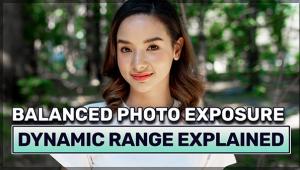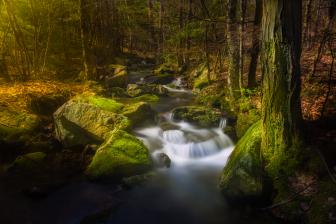Mamiya Press; A Medium Format Rangefinder Camera Page 2
Each lens had a Seiko blade shutter with speeds ranging from 1-1/500 sec plus
bulb. There is a lever on the shutter to set the sync for either "X"
for electronic flash, or "M" for flash bulbs, but, being a blade
shutter, you could use any shutter speed available with either type of flash.
A PC terminal on the side of the shutter accepted any standard PC sync cord
from a flash gun, portable or studio electronic flash unit. The shutter must
be cocked prior to each exposure and is tripped either by a long lever at the
lower edge of the shutter or via a cable release. For easier ground-glass focusing
when taking extreme close-ups, a lever on the lens instantly opened for focusing.
There are click-stop detents at each full shutter speed and for full f/stops
for positive setting of the exposure.
Since there were no bellows, the camera/lens combinations mounted on the body were very rugged and wind-resistant. Thus the camera could be used under extreme conditions such as sports or aerial photography.
There was no double exposure prevention so the user had to remember to first cock and trip the shutter then advance the film to the next frame after taking each picture. After making an exposure, a small button below the rapid-wind lever on the roll back was moved to the right to permit advancing the film to the next frame. A dark slide in the front of each rollfilm back permitted the back to be removed while film was inside for ground-glass focusing, to attach another roll back with a different type or speed of film, or for attaching a Polaroid back for exposing an instant print. In addition, the dark slide must be in place when changing lenses or that frame of film will be fogged. The roll backs were easily removed by turning two small rotating locks at the bottom of the camera body then pivoting the base of the back out from an alignment slot at the top of the body.
Two sets or formats of roll backs were offered, one for the older 6x9cm format and one for the newer 6x7cm format that was directly compatible with standard enlarging paper sizes of 8x10, 11x14, 20x24, etc. There was a special Model K rollfilm holder that could be internally adjusted to produce either 6x9cm, 6x6cm, or 6x4.5cm images on the entire roll of 120 film. When using this back you did have to watch the number inside a red window on the back (one of a row of three windows that corresponds to the format being used) then advance the film with a knob on the left until the next number appeared. A special viewfinder mask was needed to reduce the field area when using the two smaller formats.
It was slightly tedious to load film since you had to pull out most of the paper leader to reach the take-up spool on the left before closing the back. The film did pull through the back smoothly without any tendency to stray off the intended straight path.
I have seen the Mamiya Universal Press listed recently with a 100mm lens, roll back, and the side grip for prices from $199-$400. I found ads from a few years ago for the accessory lenses priced at $500 for 65mm, $500 for 75mm, $400 for 150mm, and $700 for 250mm.
I have exposed many rolls of 120 film of all types with this medium format system camera using various focal length lenses. It has always produced beautifully detailed images that can be enlarged up to large display size prints. The coupled rangefinder was very accurate with different lenses and throughout the range of distances, from infinity to 3.5-ft close subjects. The slightly bulky camera is very easy to hold and operate with the side pistol grip and the images produced are worth the manual effort required to make each adjustment and exposure. It's truly a user-classic camera.
Since there were no bellows, the camera/lens combinations mounted on the body were very rugged and wind-resistant. Thus the camera could be used under extreme conditions such as sports or aerial photography.
There was no double exposure prevention so the user had to remember to first cock and trip the shutter then advance the film to the next frame after taking each picture. After making an exposure, a small button below the rapid-wind lever on the roll back was moved to the right to permit advancing the film to the next frame. A dark slide in the front of each rollfilm back permitted the back to be removed while film was inside for ground-glass focusing, to attach another roll back with a different type or speed of film, or for attaching a Polaroid back for exposing an instant print. In addition, the dark slide must be in place when changing lenses or that frame of film will be fogged. The roll backs were easily removed by turning two small rotating locks at the bottom of the camera body then pivoting the base of the back out from an alignment slot at the top of the body.
Two sets or formats of roll backs were offered, one for the older 6x9cm format and one for the newer 6x7cm format that was directly compatible with standard enlarging paper sizes of 8x10, 11x14, 20x24, etc. There was a special Model K rollfilm holder that could be internally adjusted to produce either 6x9cm, 6x6cm, or 6x4.5cm images on the entire roll of 120 film. When using this back you did have to watch the number inside a red window on the back (one of a row of three windows that corresponds to the format being used) then advance the film with a knob on the left until the next number appeared. A special viewfinder mask was needed to reduce the field area when using the two smaller formats.
It was slightly tedious to load film since you had to pull out most of the paper leader to reach the take-up spool on the left before closing the back. The film did pull through the back smoothly without any tendency to stray off the intended straight path.
I have seen the Mamiya Universal Press listed recently with a 100mm lens, roll back, and the side grip for prices from $199-$400. I found ads from a few years ago for the accessory lenses priced at $500 for 65mm, $500 for 75mm, $400 for 150mm, and $700 for 250mm.
I have exposed many rolls of 120 film of all types with this medium format system camera using various focal length lenses. It has always produced beautifully detailed images that can be enlarged up to large display size prints. The coupled rangefinder was very accurate with different lenses and throughout the range of distances, from infinity to 3.5-ft close subjects. The slightly bulky camera is very easy to hold and operate with the side pistol grip and the images produced are worth the manual effort required to make each adjustment and exposure. It's truly a user-classic camera.
- Log in or register to post comments

































